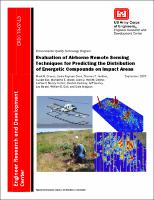Please use this identifier to cite or link to this item:
https://hdl.handle.net/11681/8508Full metadata record
| DC Field | Value | Language |
|---|---|---|
| dc.contributor | Envirostate (Firm) | - |
| dc.contributor | UT-Battelle | - |
| dc.contributor | University of Louisiana at Monroe. Department of Mathematics and Physics | - |
| dc.contributor | Cold Regions Research and Engineering Laboratory (U.S.) | - |
| dc.contributor | Army Environmental Quality Technology Program (U.S.) | - |
| dc.contributor | United States. Office of the Assistant Secretary of the Army for Acquisition, Logistics, and Technology | - |
| dc.contributor.author | Graves, Mark R. | - |
| dc.contributor.author | Peyman-Dove, Linda D. | - |
| dc.contributor.author | Jenkins, Thomas F. | - |
| dc.contributor.author | Bigl, Susan R. | - |
| dc.contributor.author | Walsh, Marianne E. | - |
| dc.contributor.author | Hewitt, Alan D. (Alan Dole) | - |
| dc.contributor.author | Lambert, Dennis J. | - |
| dc.contributor.author | Perron, Nancy M. | - |
| dc.contributor.author | Ramsey, Charles A. | - |
| dc.contributor.author | Gamey, Jeff | - |
| dc.contributor.author | Beard, Les | - |
| dc.contributor.author | Doll, William E. | - |
| dc.contributor.author | Magoun, A. Dale | - |
| dc.date.accessioned | 2016-06-20T13:27:23Z | - |
| dc.date.available | 2016-06-20T13:27:23Z | - |
| dc.date.issued | 2007-09 | - |
| dc.identifier.uri | http://hdl.handle.net/11681/8508 | - |
| dc.description | Technical Report | - |
| dc.description | Abstract: The characterization of impact area munitions constituents has typically employed traditional soil sampling approaches. These sampling approaches do not accurately account for the distribution of such contaminants over the landscape due to the distributed nature of explosive compound sources throughout impact areas, the highly localized distribution of contaminants surrounding these sources, and inaccurate records of historical target locations. Remote sensing and geographic information system (GIS) technologies were utilized to assist in the development of enhanced sampling strategies to better predict the landscape-scale distribution of energetic compounds. Remotely sensed magnetometer and electromagnetic (EM) data were used to detect and delineate areas of high densities of anomalies. The anomalies were considered to be related to targets and/or ranges likely to be highly contaminated with surface and subsurface ordnance and explosive items and artifacts. The Oak Ridge Airborne Geophysical System airborne magnetometer and time-domain EM systems were used. The magnetometer data were analyzed using GIS technology to develop a soil sampling plan based on varying levels of metal content in the ground. Soil samples were then collected and analyzed for energetic compounds. Statistical techniques found that a possible relationship (correlation) between analytic signal and the energetics measured in the soil may exist. | - |
| dc.publisher | Environmental Laboratory (U.S.) | - |
| dc.publisher | Engineer Research and Development Center (U.S.) | - |
| dc.relation | http://acwc.sdp.sirsi.net/client/en_US/search/asset/1002749 | - |
| dc.relation.ispartofseries | ERDC TR ; 07-13. | - |
| dc.rights | Approved for public release; distribution is unlimited. | - |
| dc.source | This Digital Resource was created in Microsoft Word and Adobe Acrobat | - |
| dc.subject | Analytic signal | - |
| dc.subject | Anomalies | - |
| dc.subject | Contaminants | - |
| dc.subject | Electromagnetic | - |
| dc.subject | EM | - |
| dc.subject | Energetic compounds | - |
| dc.subject | Energetics | - |
| dc.subject | Explosive compounds | - |
| dc.subject | Fort Ord (Calif.) | - |
| dc.subject | Magnetometer | - |
| dc.subject | Munitions | - |
| dc.subject | Ordnance | - |
| dc.subject | ORAGS | - |
| dc.subject | Remote sensing | - |
| dc.subject | GIS | - |
| dc.title | Evaluation of airborne remote sensing techniques for predicting the distribution of energetic compounds on impact areas | - |
| dc.type | Report | en_US |
| Appears in Collections: | Technical Report | |
